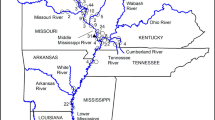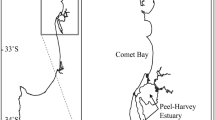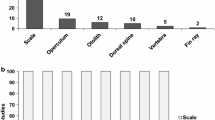Abstract
The carpsuckers, which include Quillback Carpiodes cyprinus, river carpsucker Carpiodes carpio, and highfin carpsucker Carpiodes velifer, are ictiobine catostomids (Catostomidae) native to North America. At present, the Carpiodes are classified for management purposes in a multi-species group (derogatorily labeled “rough fish”) by state agencies throughout most of their USA range. This non-specific fisheries management persists despite widespread declines among Catostomidae in North America, and as additional fishing pressures have recently evolved. Carpiodes are increasingly targeted by bowfishing with virtually no regulation, monitoring, or management. From 2018 to 2021, we analyzed the otoliths of 81 Quillback from a Minnesota population to quantify size at age, onset of sexual maturity, accrual of age spots, and recruitment dynamics. Allometric analysis revealed that otolith size increases with body mass and age at rates greater than rates for total length, scale length, and operculum length in Quillback. Our findings also indicate Quillback can possibly live at least 44 years, reach sexual maturity around ages 8–9 years, accrue black spots on epidermal tissue, similar to age-spot pigmentation in bigmouth buffalo Ictiobus cyprinellus, after 30 years, and exhibit more variable recruitment than previously documented. The life history traits of Carpiodes warrant further study for three primary reasons: the “rough fish” label has perpetuated systemic neglect, there are rising rates of exploitation, and the majority of catostomids are already classified as imperiled. Management requires updated life history data in the face of these challenges.





Similar content being viewed by others
Data availability
The data that support the findings of this study are available from the corresponding author upon reasonable request.
Change history
23 March 2023
The original version of this paper was updated to remove the Section Editor: Philippe Grellier from the article note.
References
Abràmoff MD, Magalhães PJ, Ram SJ (2004) Image processing with ImageJ. Biophotonics International 11(7):36–42
Akaike H (1973) Information theory as an extension of the maximum likelihood principle. Proceedings of the International Symposium on Information Theory 2:267-281
AnAge Database. http://genomics.senescence.info/species/. Accessed January 2022
Andrews AH, Kalish JM, Newman SJ, Johnston JM (2011) Bomb radiocarbon dating of three important reef-fish species using Indo-Pacific Δ14C chronologies. Mar Freshw Res 62(11):1259–1269. https://doi.org/10.1071/MF11080
Bass JC, Riggs CD (1958). Age and growth of the river carpsucker, Carpiodes carpio Rafinesque of Lake Texoma. Proceedings of the Oklahoma Academy of Science 50–69
Beamish RJ, McFarlane GA (1983) The forgotten requirement for age validation in fisheries biology. Trans Am Fish Soc 112:735–743. https://doi.org/10.1577/1548-8659(1983)112%3c735:TFRFAV%3e2.0.CO;2
Beamish RJ, McFarlane GA (1987) Current trends in age determination methodology. In: Summerfelt RC, Hall GH (eds) Age and growth of fish. Iowa State University Press, Ames, pp 15–42
Beamish RJ, McFarlane GA, Benson A (2006) Longevity overfishing. Prog Oceanogr 68(2–4):289–302. https://doi.org/10.1016/j.pocean.2006.02.005
Becker GC (1983) Fishes of Wisconsin. University of Wisconsin press
Beckman DW, Howlett DT (2013) 2013) Otolith annulus formation and growth of two redhorse suckers (Moxostoma: Catastomidae. Copeia 3:390–395
Beecher HA (1979) Comparative functional morphology and ecological isolating mechanisms in sympatric fishes of the Genus Carpiodes in northwestern Florida. The Florida State University
Behmer DJ (1964) Spawning periodicity of the river carpsucker, Carpiodes carpio. Proceedings of the Iowa Academy of Science 72:253-262
Bettinger JM, Crane JS (2011) Validation of annulus formation in otoliths of Notchlip Redhorse (Moxostoma collapsum) and Brassy Jumprock (Moxostoma sp.) in Broad River, South Carolina, with observations on their growth and mortality. Southeast Nat 10:443–458. https://doi.org/10.1656/058.010.0305
Braaten PJ, Doeringsfeld MR, Guy CS (1999) Comparison of age and growth estimates for river carpsuckers using scales and dorsal fin ray sections. North Am J Fish Manag 19(3):786–792. https://doi.org/10.1577/1548-8675(1999)019%3c0786:COAAGE%3e2.0.CO;2
Braaten PJ, Guy CS (2002) Life history attributes of fishes along the latitudinal gradient of the Missouri River. Trans Am Fish Soc 131(5):931–945. https://doi.org/10.1577/1548-8659(2002)131%3c0931:LHAOFA%3e2.0.CO;2
Buchholz M (1957) Age and growth of river carpsucker in Des Moines River, Iowa. Proceedings of the Iowa Academy of Science 64:589-600
Buckmeier DL (2002) Assessment of reader accuracy and recommendations to reduce subjectivity in age estimation. Fisheries 27(11):10–14
Bur MT (1976) Age, growth, and food habits of catostomidae in pool 8 of the Upper Mississippi River. Thesis, University of Wisconsin La Crosse
Burnham KP, Anderson DR (2002) Model selection and multimodel inference. Springer-Verlag. New York. 2nd edn: 60–66
Campana SE (2001) Accuracy, precision and quality control in age determination, including a review of the use and abuse of age validation methods. J Fish Biol 59:197–242. https://doi.org/10.1111/j.1095-8649.2001.tb00127.x
Campana SE (2005) Otolith science entering the 21st century. Mar Freshw Res 56(5):485–495. https://doi.org/10.1071/MF04147
Campana SE, Gagné JA, McLaren JW (1995) Elemental fingerprinting of fish otoliths using ID-ICPMS. Mar Ecol Prog Ser 122:115–120. https://doi.org/10.3354/meps122115
Casselman JM (1990) Growth and relative size of calcified structures of fish. Trans Am Fish Soc 119:673–688. https://doi.org/10.1577/1548-8659(1990)119%3c0673:GARSOC%3e2.3.CO;2
Elkin Jr, RE (1954) The fish population at two cut-off pools in Salt Creek, Osage County, Oklahoma. Proceedings of the Oklahoma Academy of Science 25–29
FishBase Database. https://www.fishbase.se/search.php. Accessed January 2022
Grabowski TB, Young SP, Isely JJ, Ely PC (2012) Age, growth, and reproductive biology of three catostomids from the Apalachicola River, Florida. J Fish Wildl Manag 3(2):223–237. https://doi.org/10.3996/012012-JFWM-008
Guy CS, Cox TL, Williams JR, Brown CD, Eckelbecker RW, Glassic HC, Siemiantkowski MJ et al (2021) A paradoxical knowledge gap in science for critically endangered fishes and game fishes during the sixth mass extinction. Sci Rep 11(1):1–9. https://doi.org/10.1038/s41598-021-87871-y
Guy CS, Willis DW (1995) Population characteristics of black crappies in South Dakota waters: a case for ecosystem-specific management. North Am J Fish Manag 15(4):754–765. https://doi.org/10.1577/1548-8675(1995)015%3c0754:PCOBCI%3e2.3.CO;2
Hanson SD, Stafford CP (2017) Modeling otolith weight using fish age and length: applications to age determination. Trans Am Fish Soc 146(4):778–790. https://doi.org/10.1080/00028487.2017.1310138
Harlan JR, Speaker EB, Bailey, RM (1951) Iowa fish and fishing. The state of Iowa
Harris PM, Hubbard G, Sandel M (2014). Freshwater Fishes of North America. 1st ed. Edited by L Melvin, J Warren, B Burr. John Hopkins University Press, Baltimore, Maryland 451–501
He F, Zarfl C, Bremerich V, David JN, Hogan Z, Kalinkat G, Jähnig SC (2019) The global decline of freshwater megafauna. Glob Change Biol 25(11):3883–3892. https://doi.org/10.1111/gcb.14753
Hoff GD, Logan MD (1997) Otolith morphology and increment validation in young Lost River and Shortnose suckers. Trans Am Fish Soc 126:488–494. https://doi.org/10.1577/1548-8659(1997)126%3c0488:NOMAIV%3e2.3.CO;2
Isermann DA, McKibbin WL, Willis DW (2002) An analysis of methods for quantifying crappie recruitment variability. North Am J Fish Manag 22(4):1124–1135. https://doi.org/10.1577/1548-8675(2002)022%3c1124:AAOMFQ%3e2.0.CO;2
Lackmann AR, Andrews AH, Butler MG, Bielak-Lackmann ES, Clark ME (2019) Bigmouth Buffalo Ictiobus cyprinellus sets freshwater teleost record as improved age analysis reveals centenarian longevity. Commun Biol 2:1–14. https://doi.org/10.1038/s42003-019-0452-0
Maceina MJ (2004) Verifying residuals from catch curves to detect recruitment variation in largemouth bass and crappies. North Am J Fish Manag 24(1):231–236. https://doi.org/10.1577/M02-162
Matić-Skoko S, Ferri J, Škeljo F, Bartulović V, Glavić K, Glamuzina B (2011) Age, growth and validation of otolith morphometrics as predictors of age in the forkbeard, Phycis phycis (Gadidae). Fish Res 112(1–2):52–58. https://doi.org/10.1016/j.fishres.2011.08.010
Morris LA (1965) Age and growth of the river carpsucker, Carpiodes carpio, in the Missouri River. Am Midl Nat 73:423–429. https://doi.org/10.2307/2423462
Minnesota Department of Natural Resources (MNDNR) (2022) State Fishing Regulations
Pacheco C, Bustamante C, Araya M (2021) Mass-effect: Understanding the relationship between age and otolith weight in fishes. Fish Fish 22(3):623–633. https://doi.org/10.1111/faf.12542
Parker B (1987) Ecology of the quillback (Carpiodes cyprinus) of Dauphin Lake. Thesis, University of Manitoba, Manitoba
Parker BR, Franzin WG (1991) Reproductive biology of the quillback, Carpiodes cyprinus, in a small prairie river. Can J Zool 69(8):2133–2139. https://doi.org/10.1139/z91-298
Pino CA, Cubillos LA, Araya M, Sepúlveda A (2004) Otolith weight as an estimator of age in the Patagonian grenadier, Macruronus magellanicus, in central-south Chile. Fish Res 66(2–3):145–156. https://doi.org/10.1016/j.fishres.2003.07.003
Quist MC, Spiegel JR (2012) Population demographics of catostomids in large river ecosystems: effects of discharge and temperature on recruitment dynamics and growth. River Res Appl 28(9):1567–1586. https://doi.org/10.1002/rra.1545
Radford DS, Lackmann AR, Moody-Carpenter CJ, Colombo RE (2021) Comparison of Four Hard Structures including Otoliths for Estimating Age in Blue Suckers Cycleptus elongatus. Trans Am Fish Soc 150(4):514–527. https://doi.org/10.1002/tafs.10303
Rasband WS (1997) ImageJ. US national institutes of health, Bethesda, MD
Rypel AL, Saffarinia P, Vaughn CC, David SR et al (2021) Goodbye to “Rough Fish”: Paradigm Shift in the Conservation of Native Fishes. Fisheries 46(12):605–616. https://doi.org/10.1002/fsh.10660
Scarnecchia DL, Schooley JD (2020) Bowfishing in the United States: History, status, ecological impact, and a need for management. Trans Kans Acad Sci 123:285–338. https://doi.org/10.1660/062.123.0301
Scarnecchia DL, Schooley JD, Lackmann AR, Shattuck ZR et al (2021) The Sport Fish Restoration Program as a funding source to manage and monitor bowfishing and monitor inland commercial fisheries. Fisheries 46(12):595–604. https://doi.org/10.1002/fsh.10679
Schnute J, Fournier D (1980) A new approach to length-frequency analysis: Growth structure. Can J Fish Aquat Sci 37:1337–1351. https://doi.org/10.1139/f80-172
Scoppettone GG (1988) Growth and longevity of the cui-ui and longevity of other catostomids and cyprinids in western North America. Trans Am Fish Soc 117(3):301–307. https://doi.org/10.1577/1548-8659(1988)117%3c0301:GALOTC%3e2.3.CO;2
Smith MW, Then AY, Wor C, Ralph G, Pollock KH, Hoenig JM (2012) Recommendations for catch-curve analysis. North Am J Fish Manag 32(5):956–967. https://doi.org/10.1080/02755947.2012.711270
Snow RA, Porta MJ, Bogner DM (2020) Examination of the Current Oklahoma State Record Smallmouth Buffalo. Proceedings of the Oklahoma Academy of Science 100: 16-21
Spiegel JR, Quist MC, Morris JE (2010) Precision of scales and pectoral fin rays for estimating age of highfin carpsucker, quillback carpsucker, and river carpsucker. J Freshw Ecol 25(2):271–278. https://doi.org/10.1080/02705060.2010.9665077
Stucky NP, Klaassen HE (1971) Growth and condition of the carp and the river carpsucker in an altered environment in western Kansas. Trans Am Fish Soc 100(2):276–282. https://doi.org/10.1577/1548-8659(1971)100%3c276:GACOTC%3e2.0.CO;2
Sylvester RM, Berry CR Jr (2006) Comparison of white sucker age estimates from scales, pectoral fin rays, and otoliths. North Am J Fish Manag 26:24–31. https://doi.org/10.1577/M04-147.1
Terwilliger MR, Reece T, Markle DF (2010) Historic and recent age structure and growth of endangered Lost River and Shortnose suckers in upper Klamath Lake, Oregon. Environ Biol Fishes 89:239–252. https://doi.org/10.1007/s10641-010-9679-9
Thompson KR, Beckman DW (1995) Validation of age estimates from White Sucker otoliths. Trans Am Fish Soc 124:637–639. https://doi.org/10.1577/1548-8659(1995)124%3c0637:VOAEFW%3e2.3.CO;2
Trippel EA, Harvey HH (1991) Comparison of methods used to estimate age and length of fishes at sexual maturity using populations of white sucker (Catostomus commersoni). Can J Fish Aquat Sci 48:1446–1459. https://doi.org/10.1139/f91-172
Trzpuc DJ (1972) The Biology and Ecology of River Carpsucker, Carpiodes carpio (Rafinesque), in the Little Missouri Arm of Lake Sakakawea. Thesis, University of North Dakota, North Dakota
Vanicek D (1961) Life history of the quillback and highfin carpsuckers in the Des Moines River. Proceedings of the Iowa Academy of Science 68(1):238-246
von Bertalanffy LA (1938) Quantitative theory of organic growth (inquiries on growth laws II). Hum Biol 10:181–213
Walburg CH, Nelson WR (1966) Carp, river carpsucker, smallmouth buffalo, and bigmouth buffalo in Lewis and Clark Lake, Missouri River. Bureau of Sport Fisheries and Wildlife
Winter TJ, Johnson T (2021) Walter J. Breckenridge Chapter Izaak Walton League of America - Minnesota Fishing Regulations to Protect All Native Fishhttps://www.breckenridgeikes.org/issues-and-resolutions. Accessed 18 Feb 2022
Woodward RL, Wissing TE (1976) Age, growth, and fecundity of the quillback (Carpiodes cyprinus) and highfin (C. velifer) carpsuckers in an Ohio stream. Trans Am Fish Soc 105(3):411–415. https://doi.org/10.1577/1548-8659(1976)105%3c411:AGAFOT%3e2.0.CO;2
World’s Forgotten Fishes. World Wildlife Fund (WWF) (2021) https://wwfint.awsassets.panda.org/downloads/world_s_forgotten_fishes__report_final__1.pdf. Accessed 23 Feb 2021
Young SP, Grabowski TB, Ely PC, Isely JJ (2010) First record of Carpiodes velifer (Highfin Carpsucker) in the Apalachicola River. Fla Southeast Nat 9(1):165–170. https://doi.org/10.1656/058.009.0112
Acknowledgements
We would like to thank anglers including Al Lindner who donated fish for study. There is no funding to declare. We thank the University of Minnesota Duluth Biology Department.
Author information
Authors and Affiliations
Corresponding author
Ethics declarations
Ethics approval
We have treated all animals in accordance with North Dakota State University and the University of Minnesota Duluth Institutional Animal Care and Use Committee (IACUC) guidelines on animal care as specified in each protocol (IACUC protocols A17007 and 2007-38272A). The collection of specimens was conducted in accordance with all applicable laws, guidelines, and regulations. Specimen collection permits for this study were granted by the Minnesota Department of Natural Resources (fisheries research license numbers: 23775, 28375, 29788, 32489).
Conflict of interest
The authors declare no competing interests.
Additional information
Publisher’s note
Springer Nature remains neutral with regard to jurisdictional claims in published maps and institutional affiliations.
Supplementary Information
Below is the link to the electronic supplementary material.
Rights and permissions
Springer Nature or its licensor (e.g. a society or other partner) holds exclusive rights to this article under a publishing agreement with the author(s) or other rightsholder(s); author self-archiving of the accepted manuscript version of this article is solely governed by the terms of such publishing agreement and applicable law.
About this article
Cite this article
Lackmann, A.R., Bielak-Lackmann, E.S., Jacobson, R.I. et al. Otolith allometry informs age and growth of long-lived Quillback Carpiodes cyprinus. Environ Biol Fish 105, 1051–1064 (2022). https://doi.org/10.1007/s10641-022-01315-8
Received:
Accepted:
Published:
Issue Date:
DOI: https://doi.org/10.1007/s10641-022-01315-8




